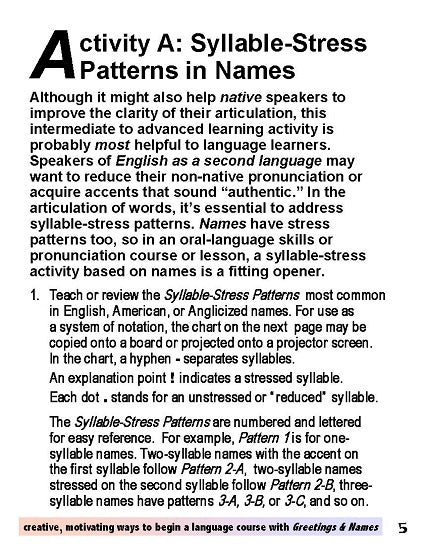Work/Life English
E-10.02b Get (Small-Format) Generic Ideas for Greetings & Names in Oral-Language-Skills Development
E-10.02b Get (Small-Format) Generic Ideas for Greetings & Names in Oral-Language-Skills Development
Creative, Motivating Ways to Begin a Language Course with a Little Book of Big Ideas: Greetings & Names, pages 1-28.
28 pages (5.5” x 4.25”)
Who It’s For: (American-) English Teachers, Helpers, & Learners Who Enjoy & Learn From Getting-Acquainted Activities & Games with Educational Aims
Why It’s Useful: For teachers and trainers—and the students they help, here’s a miniature gem of a teaching resource from a series called “Little Books of Big Ideas.” It begins with explanation on the importance of using people’s names. Then come suggested instructions for twelve Activities A-L. These range from “Learning About Syllable-Stress Patterns with Names” to (variants of) classics like “Name Chains,” “Name Rhythm,” and “Intro Bingo.” The more “serious pursuits” that end the booklet are “Mini-Writings” and “Mini-Speeches” on the Topic of Names, of course. What else is there?
What You’ll Do:
[1] Embrace the importance of using people’s names in the worlds of work / education and everyday life: it’s summed up on the first page of this little book. Look over the Table of Contents. Some of the listed Activities A-L will sound familiar while others will evoke curiosity. Read a little more of its “teacher talk.”
[2] Activity A: Syllable-Stress Patterns in Names presents a uniquely convenient way to start an Oral-Skills course with an important pronunciation principle. Activities B-H offer variants of standard mingling, circle, and chain activities; they have titles like “Asking Names,” “Collecting Names & Numbers,” “Name Rhythm,” “Departure Chains,” “Self-Intro Circles,” and “Let’s Shake on It.” Activity I: Name & Introduction Bingo consists of a generic series of info-exchange steps that nearly always work.
[3] Activity J suggests how to use photos of participants in language-skills lessons. Activities K & L gives steps for Mini-Writings to use as “Reading Kits” and Mini-Speeches followed up with Mini-Quizzes.
All in all, Greetings & Names is a compact, cheerful collection of methods for getting started in a course that promotes oral communication. Of course, its ideas can apply to other kinds of teaching/learning as the class or group progresses.
Couldn't load pickup availability


















